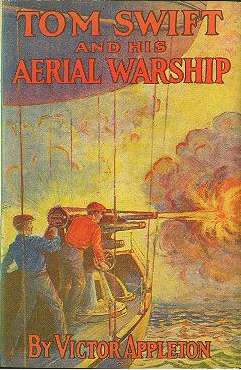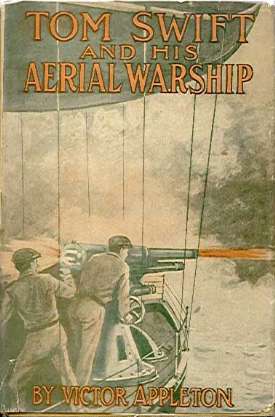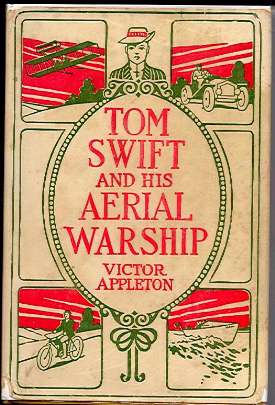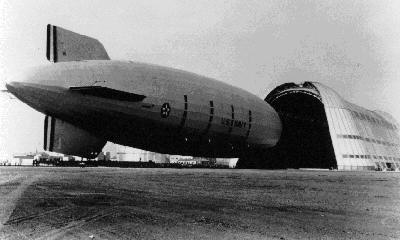 Note:
some of the language, references & attitudes, while acceptable at the time they
were written, are not Politically Correct, today.
Note:
some of the language, references & attitudes, while acceptable at the time they
were written, are not Politically Correct, today.Tom Swift and His Aerial Warship
or, The Naval Terror of the Seas
By Victor Appleton ©1915 Book #18
Review by JP Karenko, July 2005
Image of a White Quad and Duotone dustjacket is from the collection of Mark Snyder
 Note:
some of the language, references & attitudes, while acceptable at the time they
were written, are not Politically Correct, today.
Note:
some of the language, references & attitudes, while acceptable at the time they
were written, are not Politically Correct, today.
Summary:
No official summary was ever provided with any of the old Tom Swift books. However, without giving too much away, the plot can be summed up as follows:
Barton Swift has lost faith in his son's abilities as an inventor. "Putting guns and bombs in an airship just won't work," says he. (Little does he know...) On the other hand, putting an incendiary device in an explosives storage shed, does. But for quick work with a ready airship, the story might have begun with a boom, rather than a mere blaze of glory. Tom's fame and success have brought him to the attention of various nefarious foreign plotters who do not want the now-famous Swift Intellect designing devices that could be used against them in the "European Conflict." The Mars, an armed dirigible airship is one such. But for dealing with Newton's ( Sir Isaac's, not Ned's ) Second Law, Uncle Sam might have a weapon that could become the Naval Terror of the Seas.
Tom has to figure out a way to fire artillery from a floating platform and convince the US Navy to purchase this poke with most of Tom's piggy-bank tied up in it.
Hazards and pitfalls are nothing new, but how they are overcome, you will have to read the story to find out.
This book is available on line at: Tom Swift and His Aerial Warship
![]()
Cast of Characters (More or less in order of appearance)
 Tom
Swift-Intrepid
inventor & mechanic. Plucky, lively, resourceful, brave and clever.
Home-schooled at a college level by his father, Barton Swift. Athlete and
hunter. Familiar with how to stalk game and firearms (even BIG ones). Loves all
things mechanical. Is a decent cook, too.
Tom
Swift-Intrepid
inventor & mechanic. Plucky, lively, resourceful, brave and clever.
Home-schooled at a college level by his father, Barton Swift. Athlete and
hunter. Familiar with how to stalk game and firearms (even BIG ones). Loves all
things mechanical. Is a decent cook, too.
Ned Newton-Chum & companion of Tom. No description has ever been given, even though he is now a primary character in these stories. Still employed as a cashier at Shopton (National) Bank.
Koku-Giant manservant of Tom. Devoted, loyal, and possessed of great strength, but apparently somewhat limited and possibly degenerating cognitive facilities. Described as "simple and child like," he is antagonist and rival of Eradicate. He also now resides in the Swift Household. His English has improved, but is still quirky.
Barton Swift-Widower. Wealthy and conservative. Inventor master machinist and holder of numerous patents. Mr. Swift, has failed in his health of late, and seems to no longer be interested in inventing or adventure. Has turned into a doomsayer, and seems to spend all his time trying to dissuade Tom from his life of inventing.
Mr. Wakefield Damon-Elderly & eccentric adventurer whose main purpose in life seems to be blessing everybody and everything near his person. Apparently quite wealthy, he is described as "well-dressed, short, stout and fussy." In this tale, he has become very reticent to fly with Tom in his aerial contrivances.
Eradicate Andrew Jackson Abraham Lincoln Sampson, A.K.A. Rad-Aged stereotypical Negro journeyman jack-of-all-trades. "Eradicates dirt." Now suffering the ravages of old age, he now has grey hair and talks to himself. He and his mule Boomerang are growing old together. Eradicate has now "become too old to do much," but remains faithful to Tom and "helps out where he can." Boomerang now has colic.
Mrs. Baggert-Housekeeper. Kindly, and "loves Tom like a son." Employed by the Swift family for 10+ years at the time of this story. She is short of stature and has to stand on a soap box to kiss Tom goodbye on one of his voyages.
The Mysterious Foreigner-Determined to be French, a well dressed gentleman, sporting an "Imperial" moustache and beard. Pumps Rad for information about Tom's activities. Smokes "funny smelling" cigarettes.
Lt. Marbury, USN-NFN. Tall, erect American with an open honest face. Sent by Navy to oversee and evaluate Tom's new dirigible.
Rodney-NFN or description. Swift Co. messenger boy.
The Suspicious Machinist-Feldman, NFN or description. Educated and respectful, he "knows his stuff" around machinery. Spy/saboteur for unnamed foreign interests.
Miss Mary Nestor ñ Budding love interest. Described as a "fair young woman with flashing brown eyes." Blushes easily, especially around Tom. Has small hands, and is called "little girl" twice, by Tom.
Helen Randall-No description given. Mary Nestor's cousin from New York City. Interested in Ned Newton.
Quartet of Nocturnal No-good-niks-Feldman, Harrison, Ransom & Kurdy- No descriptions given. All recent hires at Swift plant, they are spy/saboteurs who try to steal parts of Tom's airship and destroy the rest. Feldman is hired by the Mysterious Foreigner, above, who it turns out is a Frenchman named La Foy.
George Watson-- No description given. Trusted Swift engineer, who pilots Mars when Tom is busy.
Pierson-NFN or description given. Secret Service Agent In Charge of "the airship matter." Passing mention.
Jerry Mound-- No description given. Trusted Swift employee. Chief Engineer & engine room boss on Mars.
George Ventor-- No description given. Assistant Pilot on Mars. ( I suspect that the author forgot he already had George Watson on board, doing that job.)
Capt. Warner, USN-- NFN or description given. Lt. Marbury's commanding officer.
The Gang of Eight-Mixed bag of multinational air pirates, who hijack Mars and try to fly it to Europe. Led by La Foy, the Mysterious Foreigner, above.
![]()
Major Inventions:
 The Mars is an
armed sort-of dirigible, "about the same size as a German Zeppelin." It is the
"largest craft Tom Swift has ever built," measuring 600 feet in length by 60
feet in diameter. It has a top speed of 60mph sustained, with armament mounted.
75mph, without. (Typical speed in these days was 30-50mph, flat out.) It is to
be used primarily as an anti-shipping weapon or against fortifications on the
ground.
The Mars is an
armed sort-of dirigible, "about the same size as a German Zeppelin." It is the
"largest craft Tom Swift has ever built," measuring 600 feet in length by 60
feet in diameter. It has a top speed of 60mph sustained, with armament mounted.
75mph, without. (Typical speed in these days was 30-50mph, flat out.) It is to
be used primarily as an anti-shipping weapon or against fortifications on the
ground.
Power is supplied by one unspecified gasoline motor apparently driving the usual dynamo-electric motor rig through three propellers, mounted toward the rear of the envelope. Sufficient battery capacity is on board to keep operations going for 24 hours in case of main engine breakdown or battle damage. Food and fuel are carried for two weeks cruising, and accommodations are in the typical Swift Spartan Style, with individual staterooms, a central lounge, and a separate galley. The cabin/gondola is suspended underneath the "semi-rigid gas bag." It is in three sections: 1) Pilot house/combat control center, forward. 2) Lounge/galley/living quarters, amidships and 3) Engine/mechanical/storage rooms (and presumably fuel/oil/ammo/batteries,) aft. All compartments interconnect.
Armament consists of fore & aft mounted 4-inch bore cannon. Two "quick-firers" of unspecified caliber and type are mounted on each side. Port and starboard forward and aft quarters are thus protected. A single machine gun can be deployed through an opening in the top of the gas bag to provide defensive fire against attack from above. There are also three magnetic release bomb drops that can be accessed (presumably for reloading) from the center compartment.
Lift is provided by a "non-burnable gas" of unspecified type and composition, (probably Helium) which can be made on board. (See errata.)
![]()
Commentary on Society, Attitudes, Environment & Errata
It's amazing how much technology and society have changed in the last 95 years. Reading the old Tom Swift Sr. series has really given me an appreciation of how much Society's attitudes have changed. I wonder what people will be taking for granted 100 years from now, and what they will think of our "modern" society and its' mores (or lack of them...)
Attitudes and Prejudices- Language usage was interesting, with many "quaint" words of wisdom quoted, usually by Ned Newton. Domestic attitudes were typical, with Rad and to a lesser extent Koku, being denigrated with the usual racial stereotypes and derogatory descriptions. However, there is a new xenophobia that is exhibited toward anyone who is "foreign." British, French, German, Russian, and Italian characters are all treated with equal suspicion and disdain. The "European Conflict" is made mention of twice, but not with any depth. America is riddled with spies and saboteurs representing (mostly) the countries above, and all are hostile toward the US. What is interesting is that even the countries warring with each other in Europe are all united in plotting against America, which has not yet entered the conflict and at the time was isolationist/neutral, and determined to remain so.
Ned Newton comes up with an idea for an artillery recoil reducer (See Errata) and Tom, uncharacteristically, gives him credit for it. Enthusiastically! Several times!! Our hero has in the past, unabashedly grabbed credit for other peoples' ideas and claimed them for his own--after "improvement," of course.... (Koku actually found the secret of the Great Searchlight, and Rad discovered the secret to making the Photo Telephone work, in previous volumes.)
Errata- Mr. Damon has been left residing in Waterford, NY. This is now four books in a row, and the score is tied! The current tally of his many moves between Waterford and Waterfield stands at 9-Waterfield, 2-not recorded, and 9-Waterford, for 18 volumes, to date. The numbers don't total, because two volumes have him residing in both places at the same time, and two do not specify his hometown. No, he does not maintain two domiciles...Different authors just can't seem to coordinate their notes.
Speaking of new authors: Once again, we have a new "look and feel" in Tom's Universe. There was not a single typo or malapropism noted in the entire text. The level of grammar and usage was also improved. On the other hand, this story is the first of many, (unfortunately) where the use of "padding" was very obvious to stretch the bulk of a 75 page story text to fit a 225 page format. Endless repetition made reading tedious with as many as six or more steps being used to stretch a given story line incident. 1) I have a feeling that x could possibly happen. 2) Do you really think x could really happen? 3) Maybe we had better plan (or have an invention in place) just in case x happens. 4) No, x couldn't possibly happen, 5) By Jove, x did happen! 6) I wonder why x happened? 7) It's a terrible thing that x happened. 8) Good thing Tom invented y to take care of x happening. 'Scuze me while I go barf...too much of a good thing.
Along the lines of the "new guy" doing the writing, characters do not behave as expected. Normally nearly fearless Mr. Damon, turns into a "nervous Nellie" and does not want to fly in Tom's latest creation. Ned has mood swings that would befit a manic-depressive, and Koku's English undergoes another transformation toward "normal" but now, he "knows nothing of mechanical things" and "can't be trusted to tighten up a simple nut." This is the same fellow who saved Tom's bee-hind by holding together a broken motor mount while standing watch (alone) in the engine room of an earlier airship.
There is also some pretty inane behavior, too. After Mars gets hijacked by armed and desperate foreign spies ( a veritable United Nations' worth ) Mr. Damon suggests that: they "get out of their prison, (an empty store room) call a policeman and have them (the spies) prosecuted." Mr. D. even volunteers the services of his lawyer "to exact the full punishment proscribed by statute." It also appears that confronting armed pirates over open ocean with "indignant" attitudes and claims of "rights" are also considered viable plans. Reality check: did I just hear gunshots and splashing noises, or just a long fading yell and a splash??? The author has apparently never seen how big the muzzle of even a "little" pistol looks when it's pointed at you in anger. It's an experience I can't recommend.
One of the biggest innovations in light gunnery was the French 75mm (3 inch) gun. It had an efficient hydro-pneumatic recoil absorption mechanism. Beginning with the Model 1897 French 75-mm rapid-fire field piece, the famous French '75, made it possible to combine great accuracy with high rates of fire. Most of the light guns of the time were howitzers, used for high-angle firing. Guns like the French 75 could also be used in a direct-fire role. Ned's idea was in use for almost 20 years. He merely "reinvented the wheel."
Engineering and Science, Fact vs. Fantasy-
Some factual data are from http://www.blimpinfo.com/ your source for all things Lighter Than Air.
Helium is a colorless, odorless, tasteless chemical element, one of the "noble" gases. While it is the second most abundant element in the universe, significant amounts are found on Earth only mixed in with natural gas. Rather than Tom's highly explosive magic lifting gas used in previous airships, this must be the vapor of choice for Mars, as a war machine would have to be able to withstand both offensive and defensive gunfire without burning. The downside of this conclusion, is that Helium only occurs in nature and cannot be manufactured at need, as was stated in the story.
The ballast Tom drops to put out the Red Shed Fire at the beginning of the story was indeed most likely sand, since most smaller balloon-type airships used it. Whether there was enough to smother a sizeable fire is problematic. Watching the yo-yo effect when Tom dumps most or all of his ballast load on the fire must have been comical. The gas would have had to be rapidly vented to prevent Tom from landing in Oz or some other faraway place, but not too rapidly, causing a smash. Water is the traditional ballast in rigid airships, since it is cheap and plentiful. Ballast must be expendable, being anything with weight that can be jettisoned from the vehicle. Ballast is dropped by an airship to compensate for lost lifting gas or to ascend more quickly.
Armament: Mars is described as a "sort-of" Zeppelin. The frontispiece illustration and dust jacket, show Tone-Deaf Tom and Nearly Headless Ned touching off a 4-inch cannon in a canoe-shaped gondola suspended by cables. Aside from the lack of hearing protection, anyone near this sort-of recoilless setup would get blown or tossed overboard.

In order for the "sort-of" recoilless cannon idea to work, one would need a clear field of fire both in front-of and behind the cannon/quick-firer in question. This would give extremely limited field of fire to prevent back-blast from destroying the gas bag, gondola or gunnery officers. I also suspect the heavy cannon and other armament would have to be kept close to the airship centerline to prevent severe weight and balance issues as ammunition was expended. Also, no-one ever explained how a blimp can sink a battleship with a pair of mere 4-inch guns. Bombs, yes, as the folks on Tirpitz found out, some 30 years later. (Those were a bit bigger than the ones carried on Mars.)
Bombs, were indeed quite practical, and Germany had great plans to use airships as bombers, until the Brits perfected a practical incendiary round for anti-aircraft machine guns and cannons. Hydrogen balloons burn beautifully, with little provocation.
Size Matters: No one has considered how big this beast really has to be to lift all that heavy ordinance and fuel/supplies. Tom's Mars had an envelope length of 600ft. ( about 200m ) Zeppelin No. 3 at 160m length had only 13000 cubic meters gas capacity and a 5500lb net lift with Helium gas. This means Mars could do a bigger all-up gross lift, but even at double the gas volume, we are talking a major load to carry. Keep in mind this beast carried a monster load of batteries as backup for the main power plant.
Costs: According to numbers found during a Google search, a 1915 era Zeppelin cost about $100,000 to build. Filling the gas bag with 26,000 cubic meters of Hydrogen (That's about one million cubic feet ) would cost $10,000. Helium is half again as expensive which means a fill-up would be $15,000, plus leakage, plus venting etc. We're talking big bucks in 1915 dollars, even for Swift Construction Co.
Construction: The Mars was described as a "sort-of" Zeppelin. It had to be either a "semi-rigid" or "rigid" design, in order to have a structure strong enough to support heavy ordinance and all that luxury.
My illustrations are modified from those found at http://www.centennialofflight.gov/essay/Dictionary/airship/DI3.htm
It is likely the author was somewhat familiar with this subject and chose to make Mars a hybrid, just so it could be "original."
It was never explained how the gun platforms were tied into the structure, either, but most of these mundane details were left up to the imagination of the reader.
Motive power: The smaller Zeppelin was powered with three 550hp motors. Tom's beast has one motor of unspecified power that apparently drives a dynamo-electric motor rigged to three propellers. These would have to be driven with exposed (shudder!) belts or chains. A saboteur shorts the electric motor with a copper bar, causing it to burn-out. I believe the author meant to say the dynamo was damaged, as they kept on under battery power. A burnt-out motor would not work with or without batteries.
Geography- Swift Construction Company has sprung from the loins of the author, full grown. In the short period of time since the conclusion of Photo Telephone, a factory complex has risen with many "trusted" employees, including pilots and multiple engineers, ( -whatever happened to Garret Jackson?) an on site fire brigade, and the usual shops and labs. There's still enough open room to test-fire artillery, though. I wonder what the neighbors think of all this urban blight-this was a residential area, a few volumes back...
The typical WW2-era dirigible hangar shown below is a bit bigger than Tom's "shed" used to house the Mars. Mars was described as 600ft long by 60ft in diameter. From comments in the text, the gondola with all the mechanicals and living areas was "suspended" below the gas bag. An airship hangar is basically a barn with big doors at both ends. A structural roof (which opens completely like a giant clam, in Tom's Universe, allowing vertical take-off ) is needed to give rigidity to the walls and bear the weight of snow and wind loads. (This is upstate New York we are talking about, here.) The massive wooden structure shown below is 1,040 feet long, 150 feet high and 296 feet wide. The airship is the ill-fated Macon at 840 ft length. People (under fin) barely show.

JP Karenko 7/25/05
![]()
Tom Swift and his Photo Telephone | Tom Swift and his Big Tunnel | Index